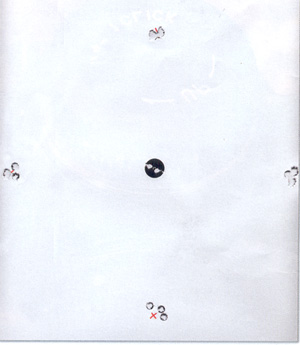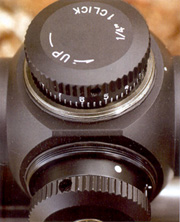LYNX SF 16x42 TACTICAL MIL DOT By Erin Boyd
I’ve written a couple of articles about Lynx products that provided a brief outline of the company and its large range of optical equipment, so suffice it to say that while they are relatively new kids on the block, the mission statement of the company is to provide “The best value and after sales service”.
From what I’ve seen of the Lynx line so far, they are competitive, well made items in the mid price bracket, and are backed by a decent guarantee.

The Lynx SF (Side Focus) 16 x 42 Tactical 30mm scope is a specialist long range item with a Mil-Dot reticle and three turrets. The elevation and windage controls have large, low profile, finger-adjustable click stop turrets, with ¼” adjustments. 50 inches of elevation and windage are available thanks to 30mm tube, which should be good for approximately 1300 metre zero give or take a bit, depending on the calibre of your rifle.
The third turret is for parallax adjustment, but it is not marked in 100 yard (or metre) increments as it usually is the case with PA scopes. Rather, the parallax settings are indicated by a series of dots on the turret body, with an infinity symbol at the end. Parallax adjustable scopes with numbered calibration scales can be used as reasonably accurate range-finders (when the image comes into focus, you can read the distance off scales). In this regard then, the Lynx arrangement is somewhat of a compromise. However, once the shooter becomes familiar with the scope on a target range it would be fairly easy to use the dots to estimate the distance to any target – the position of the dots will provide a reference. The dots are graduated in diameter, so it’s just a matter of remembering which dot equates to which distance.
The diopter (focus) adjustment for the rear ocular lens is the standard fine thread and lock ring type, which makes it easy to adjust the sharpness of the reticle to suit the individual shooter’s eye. The Lynx eye relief is 90mm, and the scope weighs 510 grams. The 42mm front lens element is recessed a full 25mm, so it’s well protected from any casual damage. All lens surfaces are multi-coated. A 150mm sunshade comes with the scope as a standard item. At 340mm in length, the scope is not overly long for its magnification – it consists of a single drawn alloy tube, finished in a nice matt black anodising.
|
The reticle adjustment knobs are designed to be turned with the fingers. They move easily, with click detents. |
I mounted the scope on my BSA .323 test rifle with its Krieger match barrel, using 30mm Lynx scope mounts supplied by Malcolm Gault, the Lynx Optics Distributor based in Australia, and used a Bushnell collimator to adjust the crosshair close to zero.
Range Testing
It has been blowing regularly in Marlborough in recent months, but I did get a lull one day, and went out to my range at Vernon Station. Here I set up a target at 100 metres, and using my portable bench rest I soon had the scope sighted in on the point of aim. Feeling rather content with that easy exercise, I put my feet up and poured a coffee from my flask. While waiting for it to cool I glassed the paddock around me, and lo and behind, three rabbits, on a small rise near the gate.
“287 metres” my Leica range finder told me. I turned the bench in that direction, wound up the elevation to two inches, rested the rifle over the sandbag, fired three shots, and suddenly there were three less pests on the property. “Looks promising” I said to myself, and returned to the testing programme.
On this occasion I did not follow my usual procedure of checking a Scope’s return to zero capability, because I knew that Lynx’s Mil-Dot reticle should space the points of bullet impact 100mm apart at 100 metres, i.e., from the centre crosshair dot to the next adjacent dot.
I’d previously marked a target with four small red crosses 100mm from the point of aim; placing them top, left, right and bottom. I reasoned with such magnification, on a still day, in a very accurate rifle, and taking sue care and diligence, I should be able to get groups very close to, or on top of those red crosses if the Mil-Dot spacings on the reticle were accurate. It was indeed my lucky day as that is what precisely happened.
 |
The Lynx Mil-Dot Reticle allowed bullets to be placed with a very high level of precision. And yes, Erin's rifle is a tackdriver! |
As a matter of note, Lynx offers this model with a standard duplex reticle if that’s what the shooter prefers.
Practical Testing
I took the rifle and scope back out to Vernon Station on another still evening and dispatched a few pests at various ranges up to 350 metres.
With a 1.1 degree field of view and an exit pupil of 2.6, this powerful 16x42 scope is not designed for quick offhand stuff or hunting in low light conditions, like late evening or early morning, but it compared well with my 10x42 Leupold as far as brightness, sharpness and contrast were concerned. This is very good considering that the Lynx has 60% more magnification and a smaller exit pupil than the Leupold’s rating of 4.2.
The Lynx Tactical is a good scope for long, carefully considered shots, where the hunter has time to calculate the range to his target, and time also to transfer the settings to the scope. The magnification is sufficient to provide a precise aiming point on something as small as a rabbit’s head out to 300 metres, and a body shot much further than if you and your rifle are that good!
The finger adjustable turrets proved precise with a good return to zero function in its practical use, but the click detents are rather light, so you’ll need to take care when you’re altering the point of aim. The caps should be kept on when the rifle is being carried.
 |
The side mounted parallax adjuster is graduated with a series of dots, rather than the usual numbers denoting yards or metres. |
The Lynx would be suitable for a dedicated ling range varmint rifle, or a tactical rifle, at a much more affordable price than the high end scopes of similar specification. It is not really a target scope though – it is designed top be used in the field.
Erin Boyd - New Zealand Guns & Hunting - Issue #95 July/August 2006

